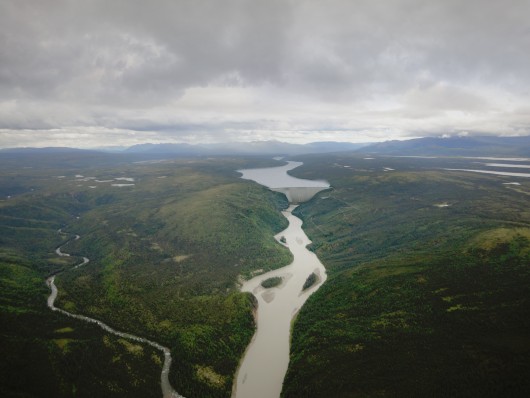The Alaska Power Association met last week in Ketchikan, and among the topics covered was hydroelectric power projects in the state.
There are three main issues limiting the expansion of hydroelectric power in Alaska: Permitting, funding and terrain.
Despite that, Alaska leads the nation in the percentage of power created by water. In the Lower 48, hydroelectric makes up 7 percent of the total power generated. Jeff Leahy of the National Hydropower Association says that, in Alaska, water provides 20 percent of the state’s electricity.
Leahey’s organization wants to increase both those numbers.
“We have a vision to double the contribution of hydropower in the United States, and our mission is to promote hydropower as America’s premier carbon-free renewable energy resource,” he said.
The holdup for that goal is that it can be really difficult to build hydroelectric projects, especially in the 49th state.
For a moment, though, let’s forget about Alaska, and consider the nationwide issue of a lengthy regulatory process. It takes many years and lots of complex paperwork to go through permitting, something Leahy and his organization are trying to change.
They’re working with lawmakers – including Alaska’s – to help streamline the process, and Leahy says there are numerous bills in the works that could help. It matters, he says, because there are more than 400 projects coming up just for relicensing in the next 15 years.
“In addition to that, there’s proposed development of over 26,000 megawatts,” he said. “We need to have a regulatory system that works better for hydropower if we’re going to get through all that work.”
So that’s permitting. Now, let’s talk about funding.
Sara Fisher-Goad is the APA executive director, and she focused on the Susitna-Watana hydroelectric project, which is still going through the permit process, by the way.
Fisher-Goad was optimistic that permitting will go smoothly, if not quickly. Money is another issue.
“I don’t usually start a slide show with a Magic 8-Ball, but it seems like in (these) budgetary times, this may be a bit of a theme: What does the future hold?” she said.
Expected funding for the $5-plus billion project combines bonds, loans and state investment, all to be repaid once the dam is up and running, but the state doesn’t really have any money to loan right now.
Last year, Gov. Bill Walker ordered a halt to all discretionary funding for the project, which is expected to eventually provide up to half of the electricity demands for Alaska’s Railbelt
Fisher-Goad says the project has slowed down – but not stopped. They’re still working on permitting, and still hope to have it up and running before 2030.
OK, we’ve covered permitting and funding. Now, finally, let’s get into Alaska’s rugged terrain.
As part of his presentation, Southeast Alaska Power Agency CEO Trey Acteson showed a brief documentary of the construction challenges SEAPA faced when building a $100-million, 57-mile intertie that connects Swan Lake hydroelectric dam near Ketchikan to the Tyee Lake project close to Wrangell and Petersburg.
Narrator: “First, consider the route, running right through the middle of the rugged mountains and valleys of the Tongass National Forest. The route was actually a compromise designed to meet the needs of a number of state, federal and environmental agencies. Secondly, no road access, meaning that everything would have to be flown in. And thirdly, of course, the weather.”
It took a lot of work and planning to string a wire across part of Alaska. The projects themselves were already built, and just needed to be connected in order to kickstart a regional grid.
For a perspective on a new project under construction, John Duhamel of the Copper Valley Electric Association gave a rundown of the 6.5-megawatt Allison Creek Hydroelectric Project near Valdez.
First, they had to get to the steep, remote site, which meant building an access road.
“There was no natural shelf in the terrain for us to build a road, so that meant that we needed to carve into the bank in some areas and build out in other areas,” he said. “In many places, the excavator had to hammer into rock to carve into the hillside.”
They also need to blast out a 750-foot tunnel to connect the lower and upper access roads, which is actually easier than building a continuous exterior path. And that’s just getting to the site.
So, to sum up: Permitting is a bear, costs are astronomical, and construction is onerous. But, the presenters say, the long-term payoff makes it worthwhile.
SEAPA’s two projects at Swan and Tyee, for example, were built in the 1980s, and are still doing exactly what they were built to do, and charging a low wholesale rate of 6.8 cents per kilowatt hour, without creating harmful emissions.
The much-bigger Susitna-Watana project is projected to reduce CO2 emissions by 1.3 billion tons a year. Fisher-Goad adds that the ratepayers will benefit financially.
“As most folks in this room know, hydro projects are capital-intensive upfront,” she said. “They’ll have an initial cost that will be more expensive that your alternatives, but you then receive an inflation-proof project for the next 50 to 100 years.”
Susitna-Watana eventually expects to charge wholesale customers an estimated 6.6 cents per kilowatt hour.
How that would translate to individuals’ pocketbooks depends on the distributing utilities, but lower wholesale rates should mean lower retail rates, something many Alaskans would welcome.
The Susitna project is not without critics. Here’s a link to a group that opposes the planned hydroelectric project. http://susitnarivercoalition.org/






